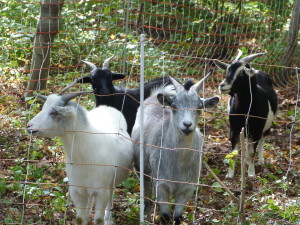Once people see a connection between their own health and the natural environment–we are all mammals, after all–the value of woodlands beyond a cool place to escape on a hot day becomes more evident. And the need to protect trees in both Blackstone parks—as the Blackstone Parks Conservancy (BPC) does–becomes more evident as well.
The Conservancy plays defense against a tangle of challenges: invading plant species, leaf-chomping insects like winter moths, and intensifying stormwater runoff–all interconnected and stoked by climate change. Braced by the Providence Parks Department and state environmental agencies, we do what we can. Litterers and vandals pose challenges as well, particularly on the Boulevard.
Fortunately, much of the work in the parks is enjoyable. Many volunteers this fall discovered this pleasure while removing invasive plants under the eyes of URI-trained BPC people as bright leaves danced overhead and cool breezes blew off the Seekonk River.
Two Innovative Approaches to Invasives and Poison Ivy
Conservancy volunteers also find satisfaction collaborating to test innovative solutions to environmental challenges. The existence of climate change is no longer seriously debated but how best to cope with it is. And there are differences of opinion on how best to control invasive plant species as well. Protection against runoff and erosion may be more obvious, but it can be difficult and expensive.
Our search for workable approaches is pragmatic: What works? What doesn’t? Are there harmful side effects? Is there a way to remove invasive plants without exacerbating erosion for instance? Ultimately, limitations of time and money encourage “small bites” through experimentation and “pilot” projects.
An invasive removal project financed partly by the Natural Resource Conservation Service began this fall at the north end of Park on Gulf Road, part of a long-term effort to move through all 45 acres. The BPC hired Groundwork Providence workers to go after Asiatic Bittersweet, Japanese Knotweed, and the City Forester, Doug Still, directed removal of a few locust trees. The latter are not on Rhode Island’s invasive species list but are moving northward, and Doug Still thinks it’s a good idea to start slowly cutting them down. Like other invasives, locusts are highly prolific and crowd out native plants.
Next, a classic conundrum: While nearly everyone would wish to eradicate all the poison ivy in the Blackstone Park Conservation District, they are protected as native plants, which are superior to invasive species in important ways. Moreover, poison ivy roots protect against runoff, and this is a priority in a park sitting on what is essentially a sand dune.
 A compromise solution in the form of hungry goats emerged, thanks to the Education Committee. Wishing to shield small children in a the new “magic” circle in the woods from the surrounding poison ivy, the committee hired a troop of nine goats from The Silk Tree Farm in Little Compton.
A compromise solution in the form of hungry goats emerged, thanks to the Education Committee. Wishing to shield small children in a the new “magic” circle in the woods from the surrounding poison ivy, the committee hired a troop of nine goats from The Silk Tree Farm in Little Compton.
Since allowing the goats to eat every plant in sight–as they would if they could–would remove protection against stormwater runoff, electric fencing was temporarily installed to keep them in bounds. The only side effect was delight, and now the Conservancy can make plans to reduce poison ivy along trails in order to protect walkers.
Priority Plans for the Boulevard
Next month look for BPC plans to deal with two pressing Boulevard issues: winter motth, and the deteriorating path, where thousands of walkers and runners pass.



